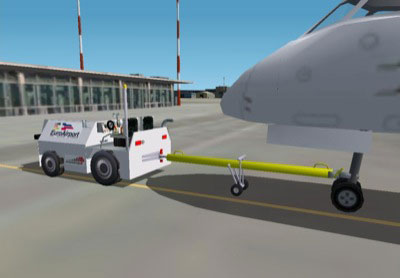Delos Aerospace patented an electric landing gear system as early as 2007, according to their web site. Steven Sullivan, an alert blog reader, provided the following lead for your editor.
Delos says, “This revolutionary technology is a total systems integration of a fully electric landing gear and maneuvering system wherein axial flux disk motor/generators replace the old friction disk technology providing increased braking and maneuvering capability to the aircraft wherein there are many engineering benefits to eliminating the heat generated within friction based braking systems.”
Use of these brakes could reduce takeoff distances and increase range by reducing fuel weight otherwise required for takeoff and cruise. Power would come from an auxiliary power unit (APU), currently part of most large jet aircraft, that would generate electricity to allow the wheels to “drive” the airplane from its parking space to the runway for takeoff, or on landing to take the airplane down the taxiway to its concourse gate. These maneuvers alone could cut fuel weight by 1,200 pounds on the average airliner, and by up to 4,000 pounds on cross-continent or intercontinental “heavies.”
Besides these fuel savings, the electric gear converts kinetic energy from a landing into electrical power and “stores that electrical power onboard the aircraft using lightweight nano enhanced ultra-capacitors. The stored energy is later used to motor the aircraft wheels in the taxiways and runways.” This operation is similar to KERS (kinetic energy recovery systems) used on Formula 1 and Lemans racers.
Dispensing with tow motors and tugs and eliminating attachments allows faster flight turnarounds and quicker trips to and from gates.
The brakes, being essentially brushless motors, have no brake pads or rotors to wear, cutting down on service and parts costs.
Since the brakes can spin up and overcome the initial rolling resistance on takeoff, they can reduce engine wear and allow lower throttle settings.
They allow better braking and provide smoother touchdowns since they can be pre-rotated to match the landing speed of the aircraft, and can then be more readily applied to retarding the forward motion of the aircraft. Delos claims their all-electric system provides feedback 1,000 times faster than hydraulically-actuated systems and 100 times faster than other electrically-actuated systems, therefore adding to the effectiveness of automatic braking systems.
Aircraft with stationary wheels when landing drive those disks from 0 to over 1,000 rpm in a half-second. This generates heat, sometimes requiring up to a half-hour cool-down before they can be safely used again. This heat affects tire wear and causes damage to the tire’s internal structure, which leads to designers specifying heavier tires to counter these effects. Delos claims that, “Conventional friction based brakes actually prevent effective levels of braking from occurring at very high power levels due to the fact that friction-based systems are much slower in feedback capability than that of a fully electrical system and the braking capacity diminishes as the friction-based brakes heat up” (and causing brake fade).
One plus this writer did not foresee is “the added benefit of adding gyroscopic stabilization to the aircraft by spinning up the landing gear tires prior to touchdown minimizing wake vortex wind influence caused by preceding large aircraft thus increasing the level of safety for smaller aircraft which could allow for shorter separation distances for aircraft thus further increasing airport capacity.”
Operators could benefit from reduced airport charges for towing and gate usage and the elimination of tug stress damage to aircraft, while airport neighbors would doubtless welcome reduced air and noise pollution.
The University of Lincoln, with funding from the Engineering and Physical Sciences Research Council (EPSRC), forms part of the Research Council’s UK Energy Program. Their studies on how to improve aircraft efficiency led to using the power generated by the aircraft on landing to recharge batteries that would allow taxiing – or even feeding that power into the local electrical grid.
Earth Techling commented on the electric taxiing feature. “This seemingly small proposal is actually a big deal when considering the low fuel efficiency and noise pollution caused by using huge jet engines to tool around the runways. In fact, engine-less taxiing was made one of the key objectives post-2020 for the European aviation industry by the Advisory Council for Aeronautics Research in Europe (ACARE).”
University of Lincoln researchers claim energy would be captured and converted into electricity by motor-generators built into the landing gear. The electricity would then be stored and supplied to the in-hub motors in the wheels of the plane when it needed to taxi.
“When an Airbus 320 lands, for example, a combination of its weight and speed gives it around three megawatts peak available power,” project leader and professor Paul Stewart explained. “We explored a wide variety of ways of harnessing that energy, such as generating electricity from the interaction between copper coils embedded in the runway and magnets attached to the underside of the aircraft, and then feeding the power produced into the local electricity grid.”
Green Car Congress has a small debate over the actual power generated by a landing Airbus, but most numbers are substantial and would seem to provide enough energy to be shared with the airport infrastructure or stored in the aircraft to allow engine-less taxiing.

